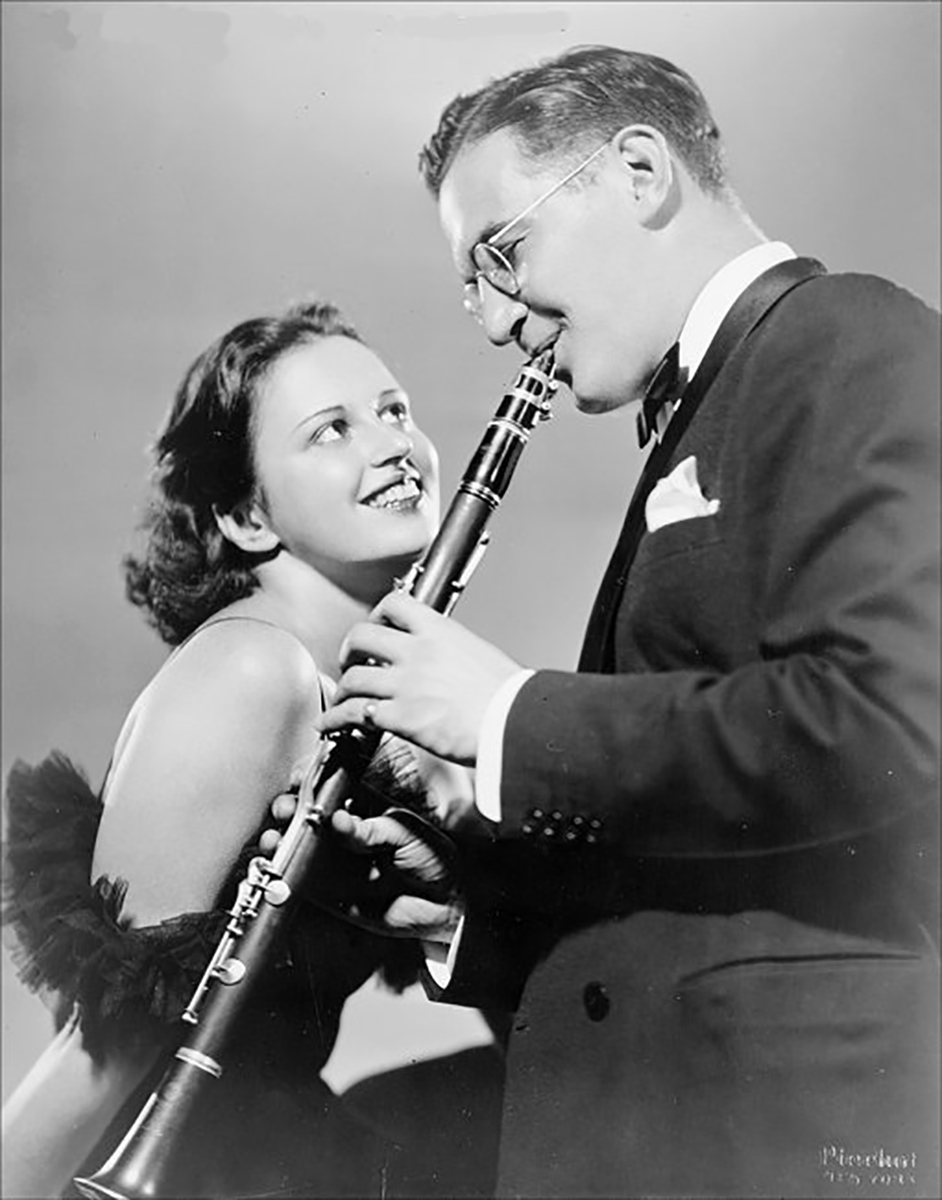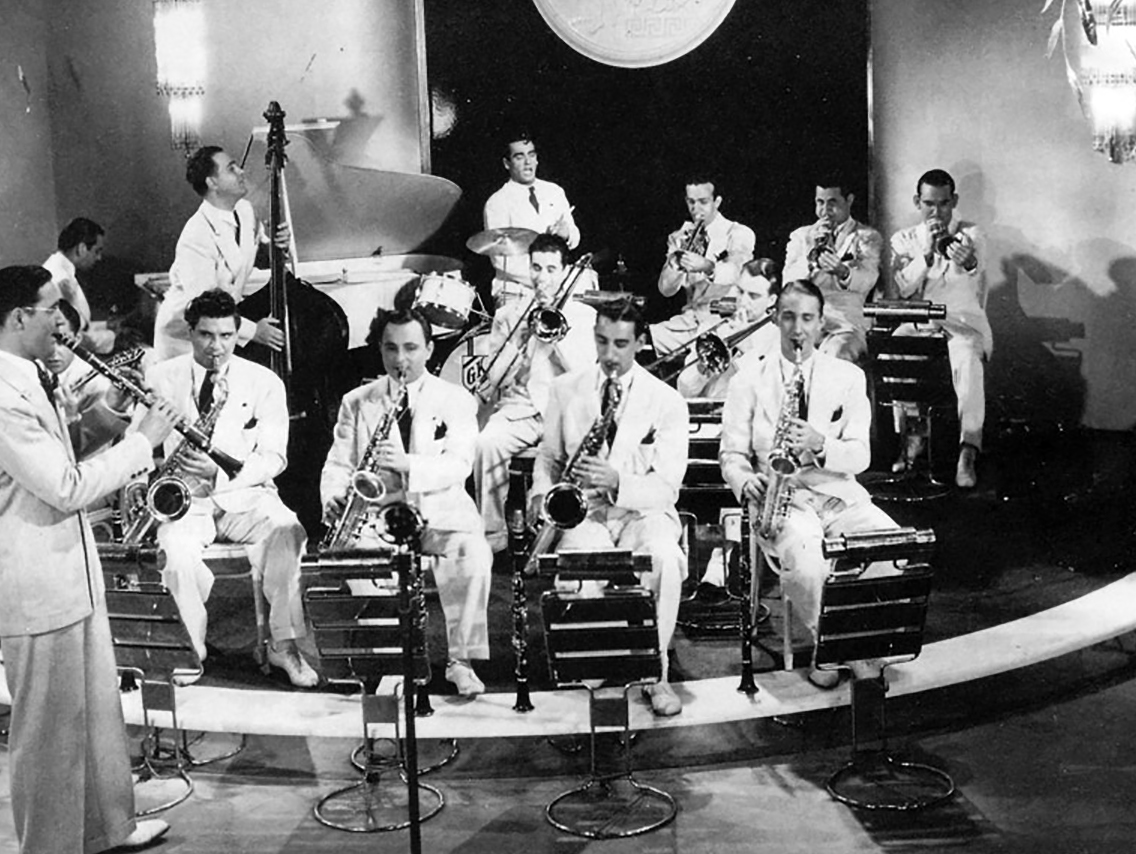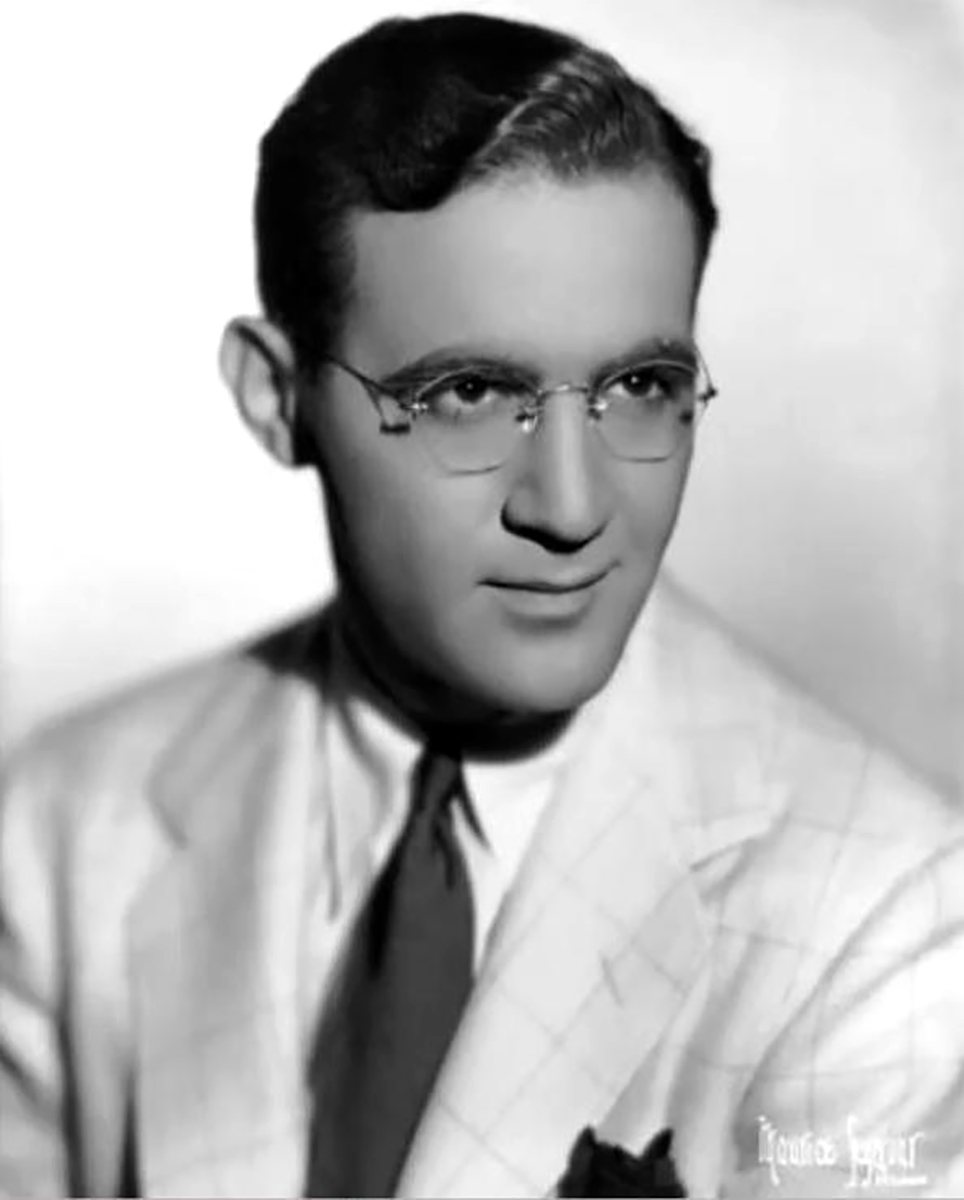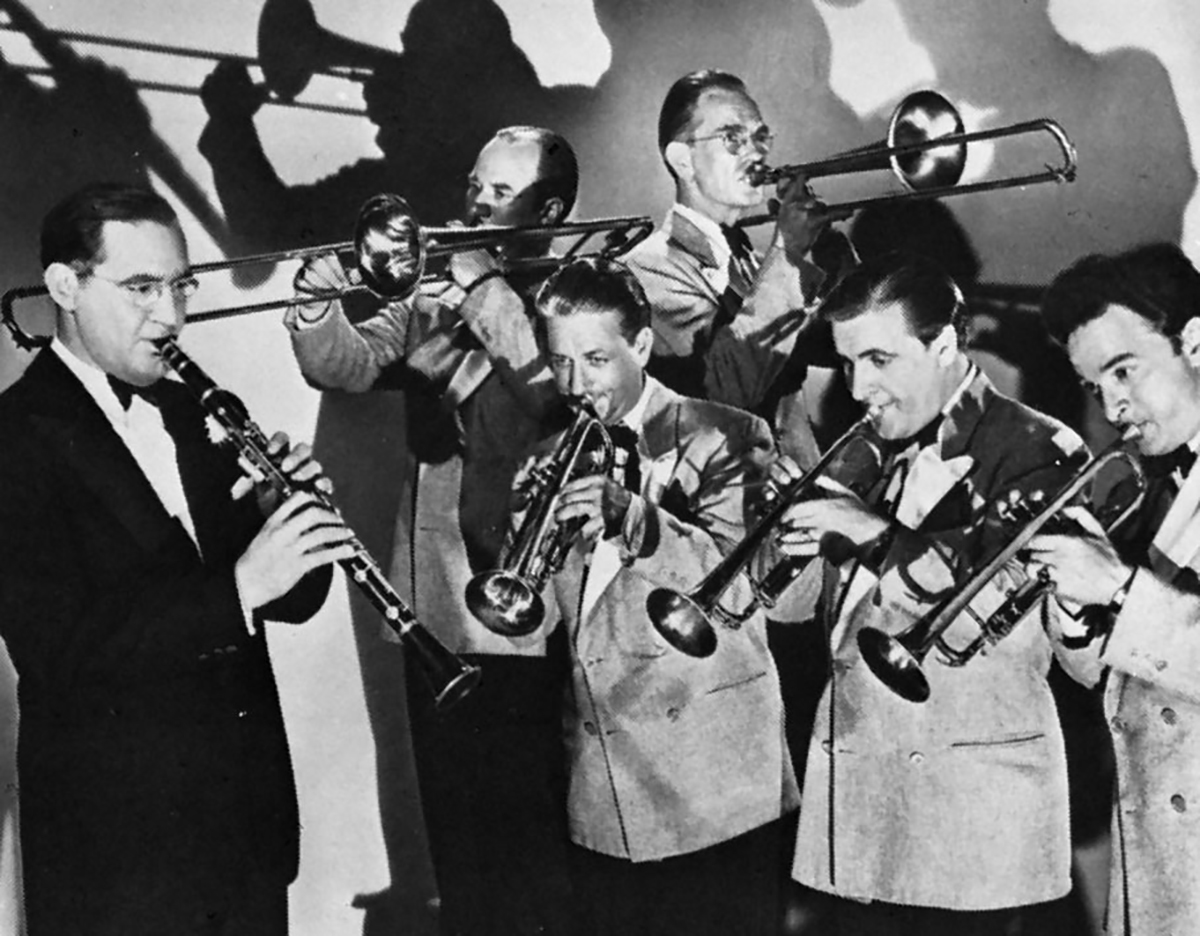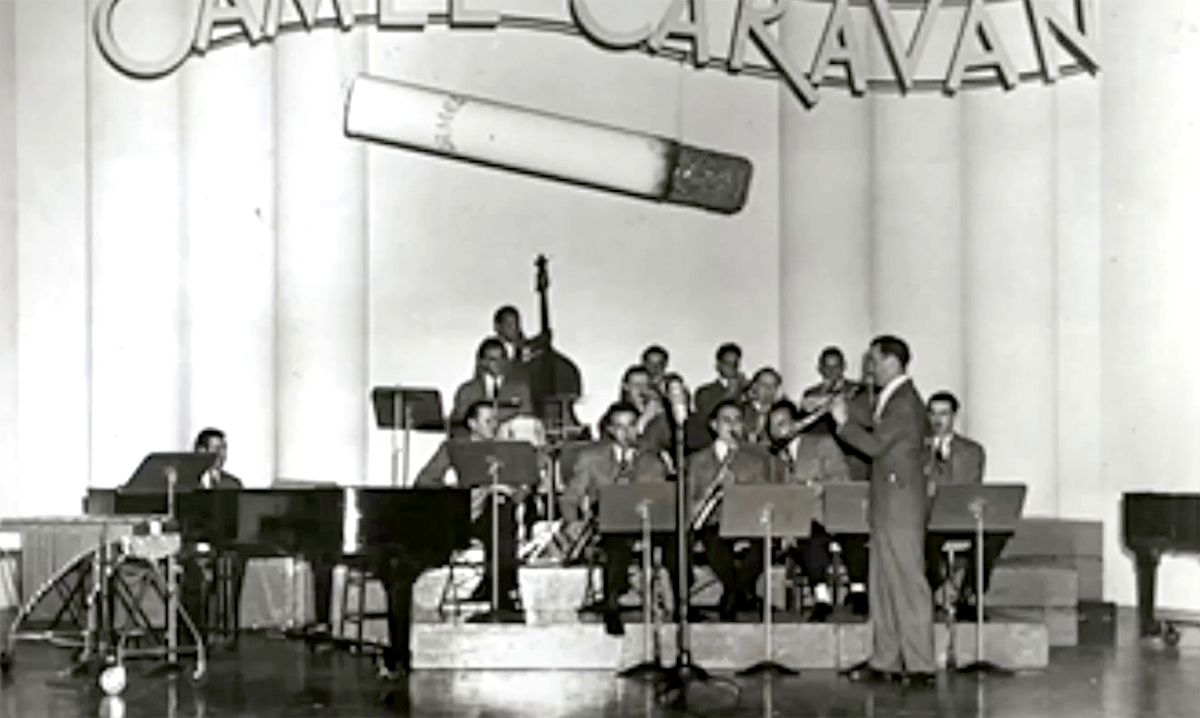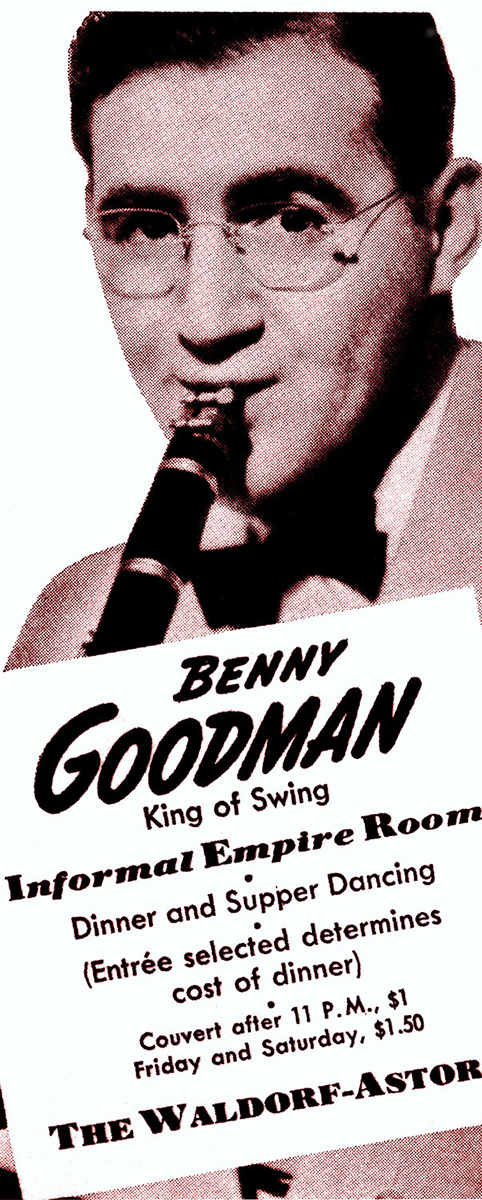Crowned the King of Swing
By 1937 the Goodman Orchestra and Jazz combos were the biggest thing in the music business playing prestigious venues. The press christened Benny the “King of Swing” and the orchestra appeared in Hollywood films. Benny’s autobiography The Kingdom of Swing was published only a month before his 30th birthday.
One possible key to Goodman’s success was his choice to prominently feature female singers. He was one of the first bandleaders to do so, beginning with very attractive and jazz-influenced Helen Ward. Her warm, direct manner was very popular with college-age males. Followed by singers Helen Forrest, Martha Tilton and Peggy Lee who all had huge hits with Goodman.
Goodman clip I – Popularity and his Vocalists, Goody Goody & Why Don’t You Do Right
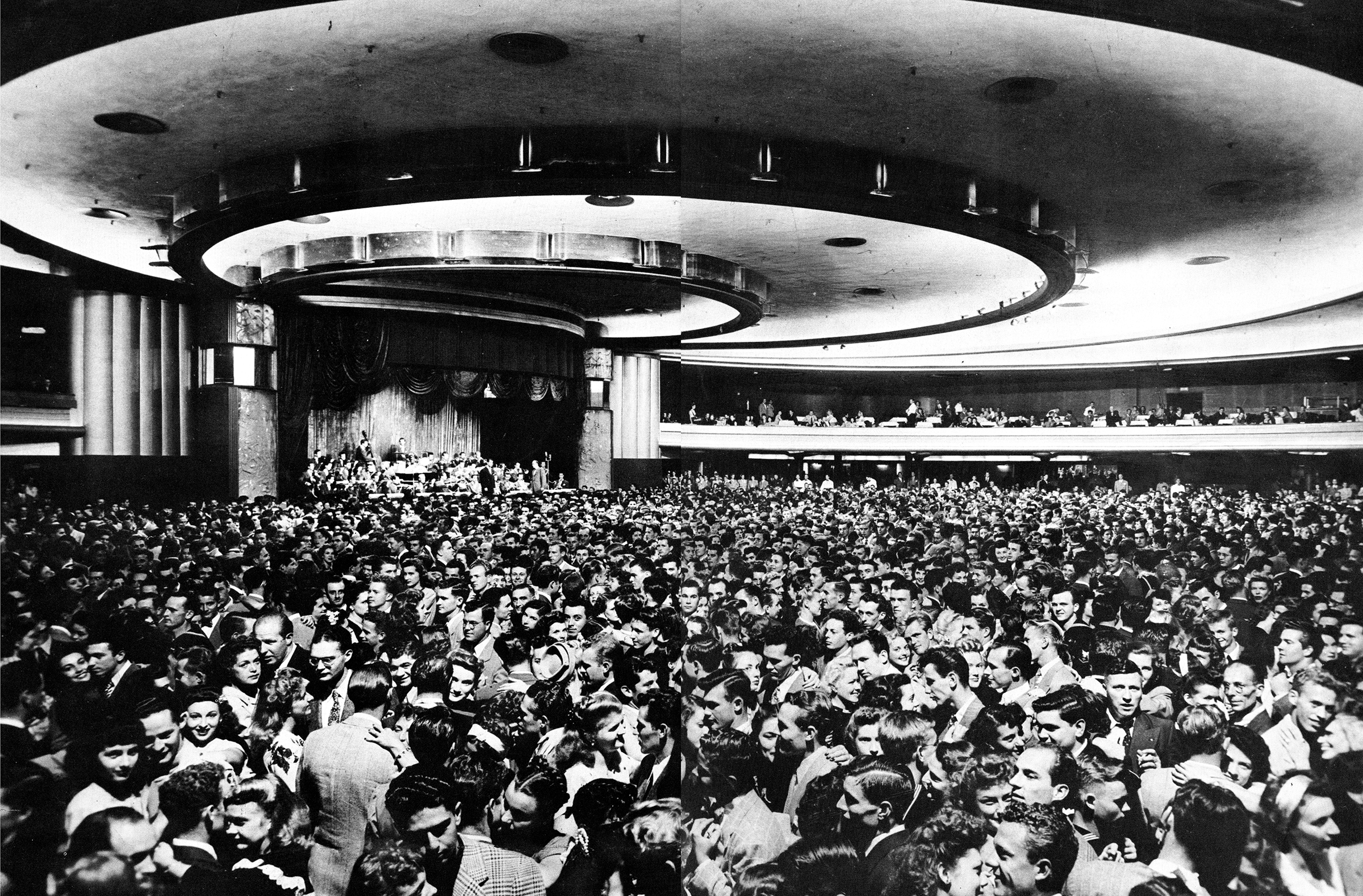
With a capacity of 6,500 dancers, The Palladium in Hollywood was the largest U.S. ballroom, seen here with Tex Beneke leading the Glenn Miller Orchestra
The Business of Swing
The Swing and Big Bands that played for vast pavilions full of dancing couples fueled a hundred-million-dollar entertainment industry. At its peak some 30,000 to 40,000 musicians were employed, backed by a support staff of another 8,000 managing, booking, promoting and transporting them.
Across America hundreds, perhaps thousands of traveling dance bands and swing orchestras packed the ballrooms of big cities and small bergs. The best, like Goodman and his crew went into the recording studios, cutting hot-selling records that rescued an industry suffering badly from the Great Depression.
It is true that during this era there were many other very good white Swing bands playing hot music for dancing. Most notably the Casa Loma Orchestra. But Goodman’s particular brand of Swing matched youthful tastes more exactly than his competitors, capturing the loyalty of a generation whose courtship rituals centered on dancing the Fox Trot.
Goodman Clip D – Live Medley 1959, 1937
Advent of the Arrangers
Arrangers were integral to the success of Swing orchestras — Goodman’s in particular. It’s often overlooked that written arrangements were crucial to focusing the sound of Swing ensembles of ten or more instruments. A small coterie of talented arrangers confronted the complex and novel task of organizing these musical forces.
With little or no formal training, the newly recruited scribes invented techniques for scoring and organizing four or five saxophones, three or four trumpets, two or more trombones and four rhythm instruments (usually piano, guitar, bass and drums). The best arrangers succeeded by keeping the melodic themes and motifs moving through the various sections, offering shifting timbral contrasts and highlighting the soloists. Mastering these delicately interlocking challenges skillfully was no small task.
The effect was greater volume, dynamic range and variation than had previously been heard in popular music. In Benny’s band, top-drawer musicians played complex written arrangements with precision and yet still cut loose with hot solos. Goodman’s arrangers struck an ideal balance between danceable rhythms, jazz improvisation, tightly written ensemble sections and that elusive but essential ingredient called ‘swing.’
He commissioned song charts from the most creative and exciting of the emerging arrangers (black or white): Jimmy Mundy, Edgar Sampson, Spud Murphy, Benny Carter and Mary Lou Williams. Foremost among them was Fletcher Henderson (and his brother Horace) who authored the charts of Benny’s biggest hits.
Goodman’s success rested firmly on expert arrangements of popular tunes, ballads and dance music played from superb written charts with improvised elements. At its best Swing was more than just very good dance music set to exciting rhythms. It was jazz.
A Simply Complex Man
A complex man, Goodman was also quite simple. Or perhaps single-minded would be a better description. Hardworking to a fault he was a perfectionist, obsessively absorbed in music and his instrument, relentlessly holding himself and others to impossibly high standards. Yet, to succeed and triumph in the tough business of American popular entertainment Goodman may well have needed that tunnel vision and focus.
Notable and somewhat unusual for a music celebrity of his stature, Goodman lived a scandal-free life, without the slightest hint of personal difficulties due to drug or alcohol abuse, money trouble, infidelity or womanizing. His marriage to Alice (nee) Hammond, who was the sister of impresario John Hammond, lasted nearly 36 years until her sudden death in 1978.
And though legend has it he was notoriously miserly, there are notable instances of his personal generosity. For instance, we know that he quietly covered the medical bills of a dying musician and retained a saxophonist who couldn’t read music but was a brilliant soloist.
The BG Ray
By all accounts, Benny was notoriously unpleasant to work for, inscrutable, absent-minded, distant, infuriating and seemingly oblivious to the feelings of his employees. The best example may be the infamous “BG Ray.” When displeased with a musician’s performance, he gave an unnerving stare of disapproval. “Benny would look right above your eyebrows,” reported singer Helen Forrest, “in the middle, right on top of the brow,” declaring that her 20 months with Goodman felt like a 20-year sentence.
Nonetheless, even Benny was able to eventually chuckle about this peculiarity. In a 1947 novelty vocal with bandleader Stan Kenton, they shared jocular passing reference to the “BG Ray.”
Goodman Clip H – BG Ray and Happy Blues
Wrapping it Up
Benny Goodman continued performing and recording vigorously through the 1940s and ‘50s. He re-launched his orchestras, bands and combos many times, commissioned new music and toured internationally. A biographical motion picture, The Benny Goodman Story was released in 1955 and shortly afterwards he made some very good recordings of his early hits in high-fidelity stereo. And Goodman became a noteworthy classical clarinet virtuoso performing with top American symphony orchestras (explored in part two).
Through his later decades Benny taught privately and developed an affiliation with Yale University where he held seminars. Today a vast archive of his music scores, papers and audiotapes reside. From this legacy, The Yale Library Benny Goodman project has issued some dozen remarkable titles.
Goodman Clip K – Summation and Benny Rides Again
Through his brilliance and focused leadership Benny Goodman shaped the Swing era, giving the clarinet an assertive leadership role in popular music. His trios, quartets and jazz combos introduced chamber music Jazz to a broad popular audience. Benjamin David Goodman won lasting admiration for his monumental contributions to 20th Century American culture.
Part two of Benny Goodman’s Kingdom of Swing examines his jazz combos with piano player Teddy Wilson, vibraphonist Lionel Hampton and electric guitar innovator Charlie Christian and offers limited-edition audio rarities. Also noted is his later, second-career performing and recording the classical clarinet repertoire.
Sources and further reading:
Benny Goodman, Giants of Jazz [box set liner notes],Philip W. Payne(Time Life, 1979)
Grove Dictionary of Jazz 2nd Ed., Barry Kernfeld editor (Macmillan, 2002)
JAZZ, Geoffrey C Ward, Ken Burns (Knopf, 2000)
Jazz Records 1897-42[discography],Brian Rust (Arlington House, 1978)
LINKS:
An excellent Goodman tribute site https://www.bennygoodman.com/
BG on Jazz Rhythm http://www.jazzhotbigstep.com/45801.html
- ← Previous page
- (Page 2 of 2)

